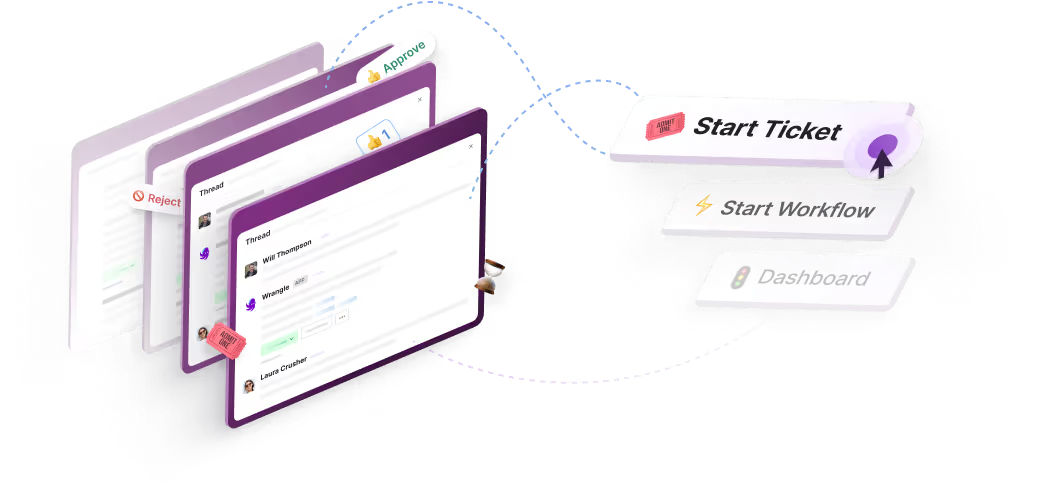What Are the SOC 2 Trust Services Principles?
In this post, we'll deep dive into the five SOC 2 trust services principles: what each is, why it matters, and more.


Protecting sensitive data is crucial for businesses to maintain customer trust and avoid costly breaches. One way to do this is by complying with the SOC 2 framework. SOC 2, which is a widely recognized auditing standard, specifically helps organizations demonstrate their implementation of effective security and privacy controls in five key areas: security, availability, processing integrity, confidentiality, and privacy. These controls can include measures such as data encryption, access controls, and vulnerability management to protect against cyber threats and attacks.
In this post, we'll deep dive into the five SOC 2 trust services principles: what each is, why it matters, its pros and cons, and examples of how to be compliant.
What Is SOC 2?
SOC 2 (Service Organization Control 2) is a framework developed by the American Institute of Certified Public Accountants (AICPA) for evaluating and reporting on the effectiveness of an organization's security controls. SOC 2 audits are designed to assess an organization's adherence to the five trust service principles.
What Are the 5 Trust Services Principles?
The five trust services principles are security, availability, processing integrity, confidentiality, and privacy. These principles are used to guide and evaluate controls over the use and processing of data by service providers.
"The security principle requires an organization to implement controls to protect against unauthorized access, theft, or destruction of its systems and data."
1. Security
The security principle requires an organization to implement controls to protect against unauthorized access, theft, or destruction of its systems and data. This principle is critical for all organizations that handle sensitive or confidential information.
Why Is Security Important?
Implementing effective security controls can help an organization avoid costly data breaches and protect its reputation. Demonstrating compliance with the security principle can also enhance an organization's reputation and increase customer confidence.
Pros and Cons of Security Controls
While implementing security controls can help protect an organization from cyber threats and attacks, it can also be challenging, especially for organizations that handle large volumes of data or operate in high-risk environments. Security controls may also be restrictive and limit an organization's flexibility.
Examples of Security Controls
To comply with the security principle, an organization can implement various security controls, including these three:
- access controls: restricting access to systems and data to authorized individuals
- encryption: protecting data from unauthorized access or disclosure by encrypting it
- monitoring and testing: regularly monitoring and testing systems to identify vulnerabilities and potential security breaches
2. Availability
The availability principle requires an organization to implement controls to ensure the availability of its systems and data. This principle is critical for organizations that rely on their systems and data to conduct their business operations.
Why Is Availability Important?
Ensuring the availability of critical systems and data can help an organization avoid costly downtime and lost revenue. Demonstrating compliance with the availability principle can also enhance an organization's reputation and increase customer confidence.
Pros and Cons of Availability Controls
While ensuring availability can help an organization maintain business continuity, it can also be challenging, especially for organizations that rely on complex systems or operate in high-risk environments. Availability controls may also be restrictive and limit an organization's flexibility.
Examples of Availability Controls
To comply with the availability principle, an organization can implement various availability controls. Here are some examples:
- redundancy: implementing redundant systems to ensure business continuity in the event of a system failure
- disaster recovery: developing and implementing a disaster recovery plan to ensure timely recovery of critical systems and data in the event of a disaster
- capacity planning: ensuring that systems have sufficient capacity to handle peak loads and prevent downtime
3. Processing Integrity
The processing integrity principle requires an organization to implement controls to ensure the accuracy and completeness of its data processing. This principle is critical for organizations that rely on accurate data to make business decisions.
Why Is Processing Integrity Important?
Ensuring processing integrity can help an organization avoid costly errors or discrepancies in its data processing. Demonstrating compliance with the processing integrity principle can also enhance an organization's reputation and increase customer confidence.
Pros and Cons of Processing Integrity Controls
While ensuring processing integrity can help an organization make accurate business decisions, it can also be challenging, especially for organizations that handle large volumes of data or operate in complex environments. Processing integrity controls may also be restrictive and limit an organization's flexibility.
Examples of Processing Integrity Controls
To comply with the processing integrity principle, an organization can implement various processing integrity controls:
- data validation: implementing controls to validate data input and processing to ensure the accuracy and completeness of data
- error handling: developing procedures for handling errors and discrepancies in data processing
- audit trails: implementing audit trails to track data processing activities and detect errors or discrepancies
4. Confidentiality
The confidentiality principle requires an organization to implement controls to protect the confidentiality of its systems and data. This principle is critical for organizations that handle sensitive information.
Why Is Confidentiality Important?
Protecting the confidentiality of sensitive data can help an organization avoid costly data breaches and legal penalties. Demonstrating compliance with the confidentiality principle can also enhance an organization's reputation and increase customer confidence.
Pros and Cons of Confidentiality Controls
Ensuring the confidentiality of data can be particularly difficult for organizations that process significant amounts of data or operate in environments with heightened security risks, such as financial institutions or healthcare providers. These organizations must apply stringent security measures, such as multi-factor authentication and advanced encryption protocols, to protect sensitive information from external threats and unauthorized access. Confidentiality controls may also be restrictive and limit an organization's flexibility.
Examples of Confidentiality Controls
To comply with the confidentiality principle, an organization can implement various confidentiality controls. Below are a few:
- access controls: restricting access to systems and data to authorized individuals
- encryption: protecting data from unauthorized access or disclosure by encrypting it
- data classification: classifying data based on its sensitivity and implementing controls to protect it accordingly
5. Privacy
The privacy principle requires an organization to implement controls to protect the privacy of personal information. This principle is critical for organizations that collect, process or store personal information.
"Apart from legal penalties and reputation repercussions, protecting the privacy of personal information is also essential for maintaining customer trust and satisfaction."
Why Is Privacy Important?
Apart from legal penalties and reputation repercussions, protecting the privacy of personal information is also essential for maintaining customer trust and satisfaction. By demonstrating compliance with the privacy principle, organizations can showcase a commitment to protecting the privacy and rights of their customers while also mitigating the risk of data breaches. Trusted business relationships built on a foundation of privacy and data protection can help organizations distinguish themselves from competitors and improve customer loyalty, which can positively impact their bottom line.
Pros and Cons of Privacy Controls
Privacy controls can be challenging to implement and maintain, especially for organizations that operate in highly regulated industries, like healthcare or financial services. Compliance with privacy regulations, such as HIPAA or GDPR, requires extensive documentation, employee training, and ongoing monitoring, which can be time-consuming and costly. Additionally, implementing strict privacy controls may limit an organization's operations, as certain data may be restricted from use or sharing. However, organizations that successfully implement robust privacy controls benefit from increased customer loyalty and trust, which can ultimately translate into long-term business success.
Examples of Privacy Controls
An organization can implement various privacy controls to comply with the privacy principle. Some examples include the following:
- data minimization: collecting and processing only the minimum amount of personal information necessary for business purposes
- consent management: obtaining and managing user consent for the collection and processing of personal information
- data retention: implementing controls for the retention and disposal of personal information
Benefits of SOC 2 Audits
By undergoing a SOC 2 audit, an organization can
- demonstrate compliance with industry standards and best practices,
- enhance its reputation and increase customer confidence,
- identify and mitigate security and privacy risks, and
- improve its internal controls and business operations.
Supplemental Criteria and Choosing the Right Trust Services Criteria
In addition to the five trust service principles, SOC 2 audits may incorporate industry-specific criteria that are relevant to the organization being audited. Here are a few examples:
1. Healthcare organizations may have additional requirements related to data privacy, such as compliance with the Health Insurance Portability and Accountability Act (HIPAA).
2. Financial institutions may have unique requirements related to transaction processing and reporting, such as compliance with the Securities Exchange Commission (SEC) or the Financial Industry Regulatory Authority (FINRA).
3. E-commerce companies may have specific requirements related to website security, such as compliance with the Payment Card Industry Data Security Standard (PCI-DSS).
4. Technology companies may have unique requirements related to software development, such as compliance with the Capability Maturity Model Integration (CMMI) or Agile methodologies.
By incorporating industry-specific criteria into SOC 2 audits, service auditors can tailor evaluations to the specific risks and challenges an organization faces, and provide valuable insights into how to improve operations and better manage risks.
How Wrangle Can Help With SOC 2 Reporting
Implementing the controls required for SOC 2 compliance can be a complex and challenging task, especially for organizations that lack in-house expertise or resources. This is where Wrangle comes in. Our ticketing and workflow automation can help your team efficiently manage the SOC 2 process from start to finish.
Unlike traditional ticketing and workflow platforms, Wrangle allows you to manage complex processes like SOC 2 compliance directly in your Slack channels. Tickets and workflows enable you to track your reviews and approvals, and Wrangle maintains a record of each request, ensuring proper auditing and compliance during your SOC 2 review.
Wrangle’s task management assigns SOC 2 related work to the appropriate individuals, and due dates and reminders keep the project moving on time. You can even use Wrangle for code review, deployments, or sensitive access.
You can try Wrangle for free or request a demo from one of our experienced solution architects.
Conclusion
In conclusion, implementing effective security and privacy controls is critical for organizations to protect their sensitive data and systems from cyber threats and attacks. The SOC 2 framework provides a comprehensive framework for evaluating and reporting on the effectiveness of an organization's security controls. By complying with the five trust service principles, organizations can enhance their reputation, increase customer confidence, and mitigate security and privacy risks.
This post was written by Joe Cozzupoli. Joe is a trusted security advisor to C-level executives with 20+ years of experience spanning multiple technologies and verticals. He’s advised Fortune 500 clients worldwide, and counseled governments, banks, and multinationals. As a thought leader in the industry, he delivers keynotes and serves on expert panels. He’s committed to developing the next generation of cybersecurity talent and holds multiple certifications, including CISSP, CCSP, CISM, CDPSE, TOGAF, and CCIE.

- Try Wrangle free for 14 days
- Turn messages into trackable tickets
- Build a scalable help desk



Turn Slack into a productivity powerhouse with Wrangle
Create a scalable helpdesk in Slack. Automatically turn messages into trackable tickets and provide faster, more transparent service to your colleagues and customers with Wrangle — Try it free!






